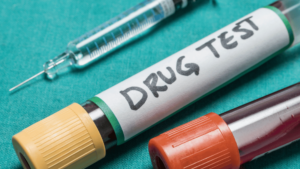Also known as alprazolam, Xanax is a popular, fast-acting benzodiazepine that is used to treat anxiety and panic disorders. Although all benzodiazepines are depressant drugs that have a tranquilizing effect on the central nervous system, Xanax is a powerful benzo that is easy to become addicted to and is one of the most frequently prescribed drugs in the United States. According to the National Survey on Drug Use and Health, over 17 million Americans used Xanax in 2017 alone.
Although Xanax is often used recreationally, it is a controlled substance that is only meant to be taken as prescribed by a doctor for a maximum of six weeks. Xanax is classified as a Schedule IV drug with a low potential for dependency, but it should still be treated with caution. Misusing Xanax is incredibly dangerous and can be lethal if taken together with alcohol or opioids.
Jump To Section
How Does The Human Body Processing Xanax?
Xanax causes the release of the neurotransmitter GABA, which produces feelings of calm and relaxation. Many people misuse Xanax to experience these feelings more frequently and can quickly develop a physical dependency on it in order to reduce feelings of stress or overwhelm. Xanax is meant to be taken orally in pill form but is sometimes crushed and snorted or injected to create a euphoric high. It takes about two hours for Xanax to reach peak levels in a person’s bloodstream. After that point, it is processed by the liver enzyme CYP3A4 into t4-hydroxyalprazolam and α-hydroxyalprazolam, which are then excreted through the urine.
How Long Is Xanax In Your System?
Xanax has a half-life of 11.2 hours, which is how long it takes for half of a dose to leave a person’s system. It takes five half-lives or 56 hours for a full dose of Xanax to leave the body, but the time frame varies depending on a number of factors including a person’s body fat percentage, age, weight, and liver health. For example, it can take about 4 days for seniors and people with poor liver health to metabolize Xanax.
Taking other medications such as antidepressants or oral contraceptives can also slow down your body’s processing rate, so it’s important to check with a doctor before taking any prescription drugs. If Xanax is not being processed effectively it can build up in a person’s system and cause serious health issues. Xanax can be detected by testing different bodily systems including your blood, saliva, hair, and urine, though urine tests are the most common method of testing.
Frequently Asked Questions
-
Why is it dangerous to consume alcohol and Xanax at the same time?
Although alcohol and Xanax affect the brain and body in similar ways, the liver always processes alcohol first which can lead to a dangerous build-up of Xanax in your body. Taking the two substances together can also cause brain damage, liver and kidney damage, respiratory issues, or cause a fatal overdose.
-
Is Xanax approved for medical use?
Yes, but it is only meant to be taken for short periods of time.
-
How often is Xanax tested for?
It depends on the industry you work in or are applying for. Because Xanax slows down brain function, military jobs or jobs that require you to drive or operate machinery often test for Xanax or other benzodiazepine use.
Blood Test for Xanax
Xanax stays in a person’s bloodstream for about 24 hours, though the detection window varies based on how long and how often someone has been taking it. Blood tests are highly accurate and almost impossible to tamper with because they are processed by a lab, making them preferable to other tests in important work or legal situations.
Saliva Test for Xanax
Xanax can be detected for up to 2.5 days in a person’s saliva, using a simple swab test.
Hair Test for Xanax
Xanax can be detected for up to 90 days in a person’s hair, making this a useful test to establish patterns of drug use or to see how someone is doing in recovery. One of the drawbacks of using a hair test for Xanax is that it may not detect immediate use because it takes time for the drug to build up in a person’s hair follicles. Hair tests also require a laboratory but are very accurate and impossible to tamper with.
Xanax Urine Test – Drug Testing Method
Xanax can usually be detected for up to 4 days in a person’s urine, though heavy use can extend the detection window to up to a week. Not all urine tests can detect Xanax, but laboratory urine tests do.
Getting Xanax Out Of Your System
Although there are all sorts of quick fixes promoted online, the only way to get Xanax out of your system is to stop taking it. If you have been using Xanax for any length of time it’s important to get professional support to help you detox. Staying hydrated and resting are the best ways to support your body and help it process Xanax as effectively as possible. Quitting Xanax cold turkey is dangerous and can cause seizures and panic attacks, so make sure to reach out to a treatment center that can assist you with the detox process.
Can You Beat A Drug Test?
No, unless you are being tested outside of the drug detection window. The only way to ensure you’ll pass a drug test is to not use Xanax.
Detoxing From Xanax
Detoxing from Xanax is the first step to healing and recovery. It is highly recommended to attend a medically supervised detox at a drug rehabilitation center so that you can receive immediate medical attention if necessary. You may experience a number of unpleasant physical and psychological side effects and it’s essential to have professional support nearby that can help you get through the process. Detoxing from a powerful benzodiazepine medication like Xanax is dangerous and should be treated like a potential medical emergency. Depending on the length and intensity of use, it may be necessary to slowly taper a person off of Xanax to prevent severe withdrawal symptoms. Common withdrawal symptoms include hallucinations, nausea, paranoia, seizures, severe anxiety, and high blood pressure. If you have been diagnosed with anxiety, PTSD, a panic disorder, or another mental health issue, make sure to get as much support as you can during the detox process.
Xanax Withdrawal
The term withdrawal applies to people who have developed a physical dependency on or are addicted to Xanax. Withdrawal symptoms usually begin 8-12 hours after your last dose and can continue for a week or more, depending on the length and intensity of use. Some withdrawal symptoms include insomnia, headaches, muscle spasms, and intense drug cravings. Psychological side effects of detoxing from Xanax include severe anxiety, delirium, depression, hallucinations, and suicidal ideation. Some people experience protracted Xanax withdrawal, which can last for up to one year.
Reach Out To Ethan Crossing For Addiction Treatment
If you or someone you know is struggling with Xanax addiction, it’s important to seek help as soon as possible. Addiction is a serious condition that can have harmful effects on your health, relationships, and overall well-being. Treatment can help you break free from the grip of addiction and begin the journey to recovery. Don’t wait any longer to take control of your life. Reach out to Ethan Crossing Addiction Treatment center today and start the path to a healthier, happier future.
Sources
https://americanaddictioncenters.org/xanax-treatment/how-long-in-system
https://www.webmd.com/connect-to-care/addiction-treatment-recovery/prescription/what-to-know-about-xanax-detox
https://www.verywellmind.com/xanax-withdrawal-4685921
https://americanaddictioncenters.org/xanax-treatment/mixing-with-alcohol















